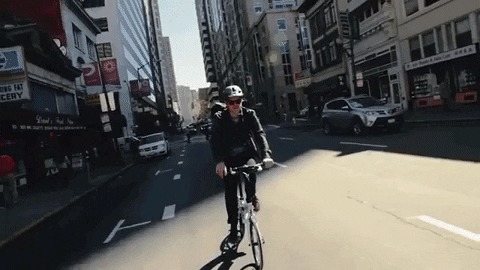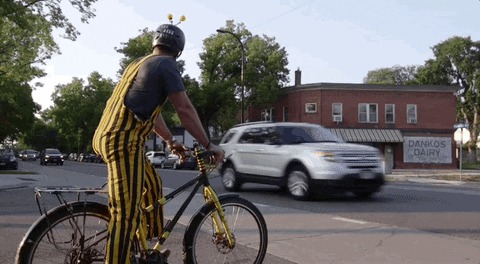
Let’s be honest: biking in Los Angeles can be incredible and a little chaotic. We’ve got ocean breezes on the Marvin Braude path, sunrise climbs in Griffith Park, and then… that left-turner on Sunset who “didn’t see you,” the sudden car door on Melrose, or the rideshare pulling into the bike lane on Venice Blvd.
If you ride in LA, you need two things: smart safety habits and a clear plan if someone’s negligence hurts you. Below is a guide with practical safety moves, what to do after a crash, and the legal rights cyclists have in California so you can ride with confidence and know exactly how to respond if the worst happens.

Quick Answers (for the “just tell me what I need” crowd)
- Can I “take the lane” in CA? Yes when it’s unsafe to ride far right, when avoiding hazards, or when preparing for a left turn.
- How much space must drivers give? At least three feet when passing.
- Helmet law? Required under 18; strongly recommended for adults.
- Sidewalks? Varies by city in LA County. LA City allows it if you don’t endanger pedestrians; places like Santa Monica prohibit it.
- Deadline to file a claim? Generally 2 years (shorter if a government entity is involved 6 months to file a government claim).
- Partly at fault? You can still recover under comparative negligence (your compensation is reduced by your share of fault).
- Do I have to talk to the other insurer? No. You can refer them to Esther The Lawyer, your lawyer.
LA-Smart Safety Tips
Think of these as habits that reduce risk in real Los Angeles traffic, not just textbook advice.
1) Ride like you’re “invisible,” communicate like you’re “loud”
Assume drivers don’t see you; make eye contact, signal early, and claim your space when needed. In LA, hesitation invites close passes clear, confident positioning reduces guessing and keeps you safer.
2) Dooring is everywhere give parked cars a buffer
On Fairfax, Melrose, and DTLA corridors, dooring is common. Create a mental “no-fly zone” next to parked cars. If the painted bike lane is in the door zone, you’re allowed to move left into the travel lane to avoid it.
3) Master intersections (most collisions happen here)
- Look for left-turners misjudging your speed.
- Control the lane through the intersection so you’re not squeezed.
- Watch right-hooks from drivers turning across your path.
- Green light ≠ safe - count a beat and scan before rolling.
4) Night riding done right
In LA, night rides are normal. Use a bright front light, solid red rear, and add side visibility (spoke lights or reflective side tape). Reflective ankle straps are small but mighty feet motion catches eyes.
5) Tech that protects
- Camera (small front/rear or helmet cam). If there’s a crash, footage can be case-making.
- Ride app (Strava, Wahoo, Garmin) location and time stamps help reconstruct events.
- Smart ID/ICE info on your phone or a wristband.
6) E-bikes: extra torque, same rules
E-bikes amplify small mistakes. Brake early, especially downhill to the beach paths. Respect speed where paths mix with pedestrians.
7) Sidewalk rules change by city
LA City: allowed if you’re not endangering people. Santa Monica, Beverly Hills, West Hollywood: different rules, and enforcement varies. If you’re unsure, default to slow, yield, or walk.
8) When a bike lane isn’t safe, don’t use it
Debris, standing rideshares, or tight door zones? You’re allowed to merge into the general lane. Do it deliberately, look, signal, move.
What To Do After a Bicycle Crash in Los Angeles (Step-by-Step)
When it happens, adrenaline takes over. Save this checklist in your Notes app.
- Get safe & call 911. Health comes first. Even if you feel “okay,” get checked for concussions and internal injuries often show up later.
- Call the police & get a report. An official record matters.
- Document everything. Take photos of vehicles, your bike, the scene, skid marks, debris, your injuries, damaged gear, and nearby cameras (building, traffic, dash cams).
- Get info. Driver’s name, phone, insurance, plate; witness names and numbers.
- Save your data. Export your ride file (Strava/Garmin), and back up any camera footage right away.
- Don’t negotiate or apologize. Be factual. Don’t discuss fault.
- See a doctor quickly. Gaps in treatment = ammo for insurers to argue you weren’t hurt. Follow the plan and keep receipts.
- Talk to a lawyer before the insurer. The at-fault carrier will look for reasons to reduce your claim. You can simply say: “Please contact Esther The Lawyer, my attorney.”
Pro tip: If a business’s driveway design or a city street defect contributed (bad sightlines, potholes), tell your lawyer immediately claims against property owners or government entities have short deadlines.

Your Legal Rights Tips
- Same rights, same rules. On most roads, you’re treated like any other vehicle operator. Drivers owe you the same duty of care they owe other motorists.
- Three-foot passing rule. Drivers must leave at least 3 feet when overtaking a cyclist.
- Lane control when needed. You can ride in the general traffic lane if the bike lane is unsafe, if the lane is too narrow to share, or when turning left.
- Comparative negligence. Even if you’re partly at fault, you can still recover damages. Your total is simply reduced by your share of responsibility.
- Hit-and-run or uninsured driver? Your own UM/UIM coverage (often on your auto policy) can cover a bicycle crash even though you weren’t driving a car. Many cyclists don’t realize they have this protection.
- You don’t owe the other insurer a recorded statement. You can politely decline and direct them to your lawyer.
- Damages you can pursue: medical bills (present & future), lost wages and reduced earning capacity, pain and suffering, property damage (bike, helmet, gear), and other losses tied to the crash.
Building a Strong Claim (What helps your case)
- Medical trail: Prompt ER/urgent care visit, follow-ups, specialist notes, physical therapy records.
- Pain journal: Short daily notes on pain levels and what you can’t do (work tasks, riding, sleep).
- Work proof: Pay stubs, letters from HR, freelance invoices.
- Bike/gear receipts: Frame, fork, groupset, wheelset, helmet, lights, computer itemize.
- Independent witnesses: Not friends/family neutral observers carry weight.
- Footage & data: Camera video, ride files, location history, photos of vehicle damage.
Avoid these common mistakes:
- Fixing or disposing of your bike before photos/appraisal
- Posting on social about the crash
- Skipping doctor visits because you “feel okay”
- Giving recorded statements
- Accepting quick cash for property damage and signing a global release (don’t)
LA-Specific Situations Cyclists Ask Us About
- Dooring on commercial corridors: It’s not “just an accident.” Opening a door into a cyclist’s path can be negligence.
- Rideshare drivers in bike lanes: Document the vehicle and the app sticker. These cases often have specific insurance layers.
- Construction zones: If temporary traffic control puts you in danger, that can create liability beyond just the driver.
- Beach paths: Mixed-use means slower speeds and extra courtesy but collisions with reckless scooter users or cyclists still create claims.

How Long Do You Have to Act?
- Most personal injury claims: 2 years from the date of the crash.
- Government involvement (bus, city street defect, public agency): 6 months to file a government claim do not miss this one.
- Minors: The clock typically starts at 18, but don’t wait, evidence goes stale fast.
The sooner you loop in a lawyer, the better the chance to secure video from nearby businesses, get a proper bike appraisal, and lock in witness statements while memories are fresh.
How We Help (And why a local lawyer matters)
Working with a Los Angeles firm that actually rides these roads matters. We know the intersections, the patterns, and the playbook insurers use to undervalue cyclist injuries. Estrada Law Group will:
- Reconstruct the crash with experts when needed
- Gather and preserve footage and sensor data
- Value your bike correctly (yes, including components)
- Handle all insurer communications
- Pursue claims against drivers, property owners, rideshare companies, or public entities
- Keep you informed in plain English (y en español)
You focus on healing, we handle the rest.
Pro Tips: Safer Rides, Fewer Close Calls
- Scan mirrors & wheel language. A drifting front wheel or angled mirror often “tells” a driver is about to move.
- Use your voice. A loud “On your left!” reduces unpredictable moves from pedestrians and other riders.
- Make yourself legible. Ride a straight line; erratic weaving invites passes.
- Upgrade your brakes/tires. Quality pads and grippy rubber buy you precious feet in an emergency stop.
- Do a 30-second bike check: Tire pressure, brakes, quick-releases/through-axles, chain.
- Carry the basics: ID, insurance card, mini pump/CO₂, tire lever, tube/plug kit, cash card, charged phone.
FAQ: Straight Answers Cyclists Want
Q1) Can I ride on the sidewalk in Los Angeles?
Short answer: In LA City, yes if you don’t endanger pedestrians. In nearby cities (e.g., Santa Monica), it’s prohibited. When in doubt, slow down, yield, or walk your bike.
Q2) I wasn’t wearing a helmet. Does that kill my case?
Not necessarily. Helmet use can be relevant to certain head injuries, but California’s comparative negligence still lets you pursue compensation. Talk to a lawyer, don’t assume you’re out of options.
Q3) The driver took off (hit-and-run). What now?
Call 911, look for cameras, and ask nearby businesses for footage. Your UM/UIM coverage may apply to bicycle collisions. A lawyer can help you open that claim and chase down video quickly.
Q4) The driver’s insurance says I was “splitting lanes.” Is that illegal on a bike?
There’s no “lane splitting” term for bicycles the way there is for motorcycles, but cyclists can take the lane when a lane is too narrow to share or when avoiding hazards. Fault depends on the specifics and don't accept their framing without legal advice.
Q5) The police didn’t come. Can I still make a claim?
Yes. A police report helps, but it isn’t required. Photos, witnesses, medical records, and your ride data can still prove your case.
Q6) How long will my case take?
It depends on injuries, treatment, and whether the insurer is reasonable. Many cases settle within several months after you finish active treatment; others go longer, especially if litigation is needed.
Q7) What does a lawyer cost?
Most bicycle injury cases are handled on a contingency fee you don’t pay upfront. The fee is a percentage of the recovery, and you owe nothing if there’s no recovery.
Q8) Do I get my bike replaced or just repaired?
If your frame or components are compromised, you can pursue replacement value (plus damaged gear like helmet, lights, computer). Don’t repair anything before the appraisal/photos.
Q9) What if a rideshare driver hit me while “between rides”?
Rideshare insurance coverage can change depending on whether the app is off, on without a passenger, or on with an active trip. We investigate the correct layer of coverage for the situation.
Q10) Can I post about the crash on Instagram/TikTok?
We get it but please don’t until you’ve spoken with a lawyer. Insurers monitor social content and may use it to minimize your injuries.
-
Biking in LA should feel empowering, not risky. Build smart habits, know your rights, and if a careless driver cuts your ride (or recovery) short, get a team that knows how to fight for cyclists.
Talk to Esther The Lawyer About Your Bicycle Accident (Free Case Review)
If you were hit on your bike, whether in Downtown LA, Riverside, Westside, the Valley, or anywhere in LA County Estrada Law Group is ready to help. We’ll handle the insurers, protect your claim, and keep you informed every step of the way.
Call now: (323) 609-5000
Email: info@estradalawgroup.com
Instagram: @estherthelawyer | @estradalawgroup
TikTok: @estherthelawyer
Heading 1
Heading 2
Heading 3
Heading 4
Heading 5
Heading 6
Lorem ipsum dolor sit amet, consectetur adipiscing elit, sed do eiusmod tempor incididunt ut labore et dolore magna aliqua. Ut enim ad minim veniam, quis nostrud exercitation ullamco laboris nisi ut aliquip ex ea commodo consequat. Duis aute irure dolor in reprehenderit in voluptate velit esse cillum dolore eu fugiat nulla pariatur.
Block quote
Ordered list
- Item 1
- Item 2
- Item 3
Unordered list
- Item A
- Item B
- Item C
Bold text
Emphasis
Superscript
Subscript



